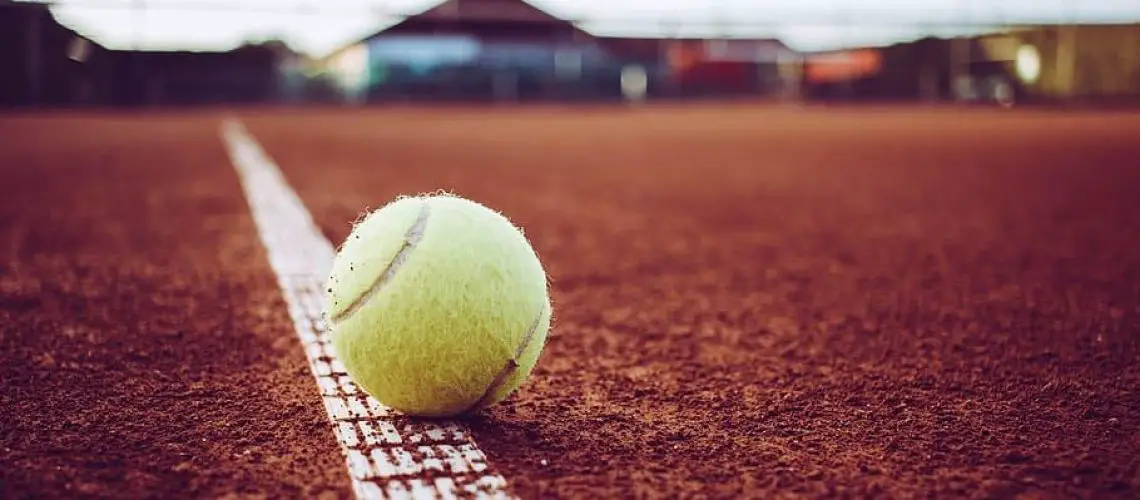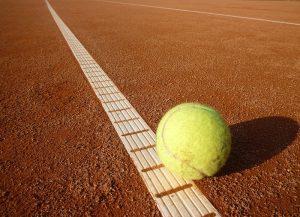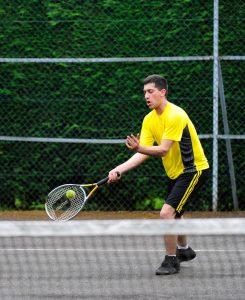We may earn money or products from the companies mentioned in this post.
Introduction to Tennis Forehand

Welcome to the world of tennis, where the forehand is often referred to as the “king” of shots A strong forehand can make or break a player’s game, acting as both an offensive weapon and a tool for consistency and control In this article, we will explore the importance of developing a powerful forehand in tennis and discuss some common challenges faced by beginners and intermediate players Additionally, we will provide an overview of the four key areas that you can focus on to improve your forehand technique
The Importance of a Strong Forehand in Tennis
When it comes to dominating your opponent on the court, having a strong forehand is crucial Let’s delve into two primary reasons why:
-
Offensive Weapon:
The forehand stroke allows you to generate substantial power and spin, making it an excellent tool for launching aggressive shots With a well-executed forehand, you can take control of rallies and put your opponent on the defensive -
Consistency and Control:
While power is important, consistency and control are equally vital aspects of any successful shot in tennis A strong forehand technique enables you to hit accurate shots with precision, giving you greater confidence in your ability to keep the ball in play consistently
Common Challenges Faced by Beginners and Intermediate Players
Mastery of the forehand stroke doesn’t come without its fair share of challenges Whether you’re just starting out or have been playing for some time, here are some common hurdles that players often face:
-
Grip Alignment:
Finding the correct grip alignment can be tricky for beginners It’s essential to understand how different grips affect your shot’s power and control -
Timing and Footwork:
Coordinating your footwork with the timing of the swing is crucial for a smooth and effective forehand Many players struggle to find the right balance between their footwork and racquet movement, resulting in inconsistent shots -
Shot Selection:
Knowing when to use different types of forehand shots, such as flat, topspin, or slice, can be challenging Choosing the wrong shot for a specific situation can lead to errors or missed opportunities -
Consistency Under Pressure:
Maintaining consistency during high-pressure situations, such as matches or tournaments, is another challenge faced by many players Nerves and mental pressure can impact shot execution and overall performance
Overview of the Four Key Areas to Improve Your Forehand
To enhance your forehand technique and overcome these challenges, it’s important to focus on four key areas:
-
Grip and Hand Placement:
Understanding different grip styles and finding one that suits your playing style is crucial for maximizing power and control -
Swing Path and Follow-Through:
Developing a consistent swing path that generates power while maintaining accuracy is essential Additionally, mastering the follow-through will help you maintain balance after striking the ball -
Footwork and Timing:
Improving your footwork will allow you to position yourself correctly for each shot Coordinating footwork with racquet preparation ensures optimal timing for powerful forehands -
Mental Preparation:
Lastly, working on mental aspects such as focus, concentration, and handling pressure will contribute significantly to enhancing your forehand performance
By dedicating time and effort to these four areas, you can gradually improve your forehand stroke and elevate your overall game on the tennis court
Technical Aspects of the Forehand Stroke

The forehand stroke in tennis is a fundamental skill that requires proper technique and execution To master this shot, players must understand the technical aspects that contribute to its effectiveness Let’s explore some key elements of the forehand stroke:
The Grip Options for Forehands
When it comes to gripping the racket for forehand strokes, players have several options to choose from:
-
Eastern grip:
This grip involves placing the base knuckle of your index finger on the third bevel of the racket handle It provides a balanced combination of control and power -
Semi-western grip:
Here, you shift your hand slightly towards the left side (for right-handed players) on the handle, placing your base knuckle between the second and third bevels It allows for greater topspin generation -
Western grip:
With this grip, you move your hand further towards the left side (right-handed players), positioning your base knuckle on or close to the fourth bevel This grip is ideal for extreme topspin shots but sacrifices some control
Stance Variations for Optimal Power and Balance
In order to generate power and maintain balance during a forehand stroke, different stance variations can be utilized:
-
Closed stance (Neutral):
In this stance, both feet are parallel to each other at shoulder width apart It offers stability and precision while allowing players to transfer weight efficiently from back foot to front foot during the swing -
Open stance:
Here, the front foot is positioned slightly towards the net, while the back foot rotates to allow for a more explosive weight transfer This stance is commonly used for wide shots or when players are on the run -
Semi-open stance:
As the name suggests, this stance falls between closed and open stances It offers a compromise between stability and mobility, making it suitable for various shot situations
Swing Path Components for Consistency and Spin
The swing path of a forehand stroke greatly influences consistency and spin generation The following components play a crucial role:
-
Low-to-high swing pattern:
By starting the swing low and finishing high, players can generate topspin on their shots This not only helps keep the ball in play but also allows it to clear the net with sufficient margin -
Topspin generation:
The low-to-high swing pattern combined with brushing up against the back of the ball enables players to impart topspin, which causes the ball to dip quickly after crossing over the net -
Margin over the net:
The upward swing path provides ample clearance over the net, reducing unforced errors caused by hitting into it -
Follow-through variants:
The way you finish your forehand stroke can impact your shot’s trajectory and control:
-
Classic follow-through:
In this variant, your racket finishes across your body towards your opposite shoulder It promotes better control while maintaining balance throughout the stroke -
Windshield wiper follow-through:
Here, your racket follows a diagonal path across your body, resembling the motion of a windshield wiper This follow-through is commonly used for generating additional topspin
Proper Racket Head Speed and Acceleration Techniques
Lastly, to maximize the power and effectiveness of your forehand stroke, it’s important to focus on racket head speed and acceleration:
-
Racket head speed:
By swinging the racket swiftly through the contact zone, players can generate more power behind their shots The faster the racket head speed, the greater the potential force exerted on the ball -
Acceleration techniques:
To achieve high racket head speed, players can employ techniques such as using their non-dominant hand to initiate the swing or utilizing proper weight transfer from back foot to front foot during impact
Mastering these technical aspects of the forehand stroke will not only improve your shot consistency but also enhance your ability to generate spin and power Practice diligently and experiment with different grips, stances, swing paths, and follow-throughs to find what works best for you!
Practical Drills for Enhancing Your Forehand

When it comes to improving your forehand in tennis, practice is key By incorporating a variety of drills into your training routine, you can refine your technique, enhance your consistency, and build endurance In this article, we will explore four practical drills that can take your forehand to the next level
Self-Feeding Drills to Refine Technique
Self-feeding drills are an excellent way to focus on specific aspects of your forehand technique One effective drill is the drop-feed drill To perform this drill, stand at one end of the court and drop the ball gently with one hand while using your other hand to execute a controlled forehand stroke This drill allows you to concentrate on wrist positioning, body rotation, and follow-through
Partner Drills for Realistic Practice Situations
To simulate realistic match scenarios and improve your ability to respond quickly, partner drills are invaluable One popular partner drill involves rallying back and forth with a designated target area in mind For instance, you could aim for a specific corner or try hitting cross-court shots only This type of drill helps develop shot selection, footwork agility, and overall shot accuracy under pressure
Wall Practice – Working on Accuracy and Consistency
Wall practice is a simple yet effective way to work on accuracy and consistency in your forehand strokes Find a solid wall or backboard at your local tennis court and stand about 10 feet away from it Hit the ball against the wall using proper technique while focusing on maintaining control and precision with each stroke This exercise improves hand-eye coordination and helps develop muscle memory for consistent shot execution
Multi-Ball Feeding Machine – Building Endurance and Efficiency
If you’re looking to enhance your endurance and shot efficiency, using a multi-ball feeding machine can be highly beneficial These machines allow you to practice hitting a continuous stream of balls without the need for a partner By adjusting the speed and trajectory of the balls, you can work on various shot types and build stamina over time This drill helps improve shot selection, reaction time, and overall stroke production
By incorporating these practical drills into your training regimen, you can make significant strides in enhancing your forehand in tennis Remember to focus on technique refinement, realistic practice situations, accuracy and consistency, as well as building endurance and efficiency With consistent effort and dedication, your forehand will become a formidable weapon on the court
Mental Strategies & Tactics for an Effective Tennis Forehand

Developing a Pre-Shot Routine for Increased Focus
In the game of tennis, focus is key Developing a pre-shot routine can greatly enhance your ability to maintain concentration and execute an effective forehand shot Your routine should be personalized to fit your style and preferences, but it should include elements such as visualizing the shot, taking deep breaths to calm your mind, and adjusting your grip and stance By consistently following this routine before each forehand, you train your brain to enter a focused state, allowing you to perform at your best
Reading Opponent’s Body Language, Positioning, and Tendencies
Tennis is not just about hitting the ball; it’s also about understanding your opponent’s game By paying close attention to their body language, positioning on the court, and previous shot choices, you can gain valuable insights into their tendencies Does your opponent favor cross-court shots? Are they more aggressive when returning low balls? Recognizing these patterns allows you to anticipate their moves and adjust your own strategy accordingly It’s like deciphering a secret code that gives you the upper hand in the game
Adjusting Your Game Plan Based on Match Situation
No two matches are alike As a tennis player, it is essential to adapt your game plan based on the specific situation at hand Is your opponent consistently returning powerful shots down the line? Maybe it’s time to mix up your angles or incorporate more drop shots into your repertoire Being agile in changing tactics during a match demonstrates versatility and keeps your opponents guessing Remember: flexibility is key when it comes to achieving success on the court
Bouncing Back from Errors and Maintaining Confidence Throughout the Match
Errors are a natural part of any sport, and tennis is no exception What sets successful players apart is their ability to bounce back from mistakes and maintain confidence throughout the match Instead of dwelling on a missed shot or double fault, focus on the present moment and visualize your next successful forehand Use positive self-talk to boost your confidence and remind yourself of your skills and abilities Remember, it’s not about avoiding errors altogether but how you recover from them that truly matters
Useful Links

Simple Tennis Forehand Tips For Hitting The Ball More …
3 Tennis Drills to Hit a Better Forehand
How to Hit a Forehand | Tennis Forehand | Tennis Swing
Tennis Forehand 101: How to Hit a Forehand in Tennis
Tennis Forehand Technique & Drills [Slow Motion Video!]
4 Tips & Drills To Improve Your Tennis Forehand
Tennis skills: improving your tennis forehand
Tennis Forehand Exercises to Develop a Killer Forehand
Forehand – Tennis Clash Wiki – Fandom
Tennis Forehand Drills
How to Hit a Tennis Forehand (with Pictures)
Forehand
What exercises can increase the power of my tennis …
Topspin Forehand I 5 Steps To Get More Topspin On Your …
How do you execute a Tennis Forehand? [Tips & …
How do I improve my tennis forehand?
Improving Forehand and Backhand Strokes
Tennis Forehand Drills
OnCourt OffCourt Tennis Forehand Rotator – Improve …






